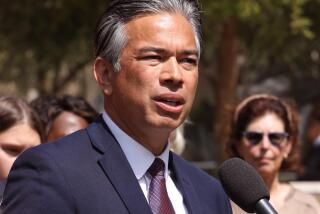Sheriff’s Plan to Treat Addicts in New Jail Facility Up for Board Vote
- Share via
Sheriff Mike Carona’s vision of building a small lock-down facility to treat jail inmates with drug problems faces its first political test this week when county supervisors decide whether to spend $1.3 million on the novel project.
Carona has made such treatment facilities a top goal in his first term as sheriff, arguing that rehabilitation is much more effective for addicts than simply putting them in regular jail cells.
The plan to build a 64-bed pilot project comes as correctional officials from Los Angeles to Sacramento begin to shed suspicions about drug treatment and lobby for state funding of such programs.
Carona’s proposal has won praise as a progressive way for law enforcement to deal with drug addiction--a social problem that resounds with the sheriff, whose mother died of alcoholism when he was a child.
But Carona prefers to publicly tout the project as a way to cut recidivism rates as part of his effort to reduce the need for future beds in one of the nation’s most overcrowded jail systems.
“You cannot do that just by kicking people out the back door,” Carona said in an interview last week.
The county Board of Supervisors will decide Tuesday whether to use an unexpected surplus in property taxes to fund the state-of-the-art facility.
If the board approves the measure, the county’s Health Care Agency will begin working with a private company--College Health Enterprises--to provide inmates with intensive drug counseling.
Inmates in the program would be segregated from the rest of the jail and would live in a special lock-down area of the Theo Lacy Branch Jail in Orange.
The program would run for three to 12 months. Upon release, inmates would have access to referral services and further counseling for another three months.
Sheriff’s officials said they believe the services can help inmates break addictions that drive many into a life of crime, even after their release from jail.
“If you’re still chemically dependent when you leave and you have no job, what are you going to do?” Carona said. “You’re going to go back to what you were doing before.”
Carona said he will track recidivism rates among graduates of the facility to ensure that the county’s program is effective. If successful, officials hope to expand the center to 500 beds.
The project, if completed, would be one of only a handful nationwide.
Marin County Sheriff’s Department in Northern California operates a treatment center that houses dozens of substance abusers. And last year, Los Angeles County Sheriff Lee Baca won praise for converting an old jail into a rehab center for about 85 sentenced drug offenders.
But the number of such treatment facilities is likely to climb in the near future, according to Nick Warner, legislative representative for the California State Sheriffs’ Assn.
In an effort to increase treatment services, the state’s sheriffs are pushing a bill to provide $50 million in state funding for drug rehabilitation in jails.
Many jail managers--desperate to ease overcrowding--have come to support drug treatment in the belief that warehousing drug offenders is not enough, he said.
“It’s very, very expensive, not to mention unfair to the offender because they don’t get the services they need while inside,” Warner said. “Treatment is a major priority for law enforcement and sheriffs in the state.”
More to Read
Sign up for Essential California
The most important California stories and recommendations in your inbox every morning.
You may occasionally receive promotional content from the Los Angeles Times.














